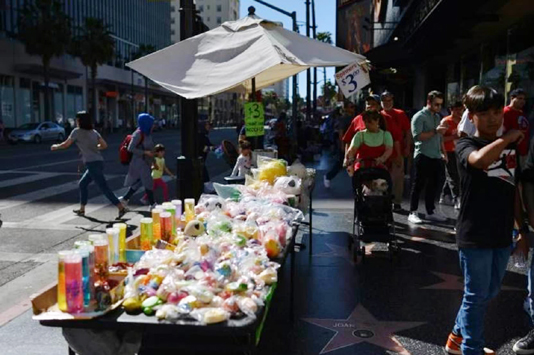LOS ANGELES, April 19, 2019 (BSS/AFP) – A chorus of street vendors’ pitches
ring out on a hot spring day in downtown Los Angeles.
“Avocados, avocados from Michoacan,” one man shouts with his foot on top
of a box filled with the fruit. “Agua fresca!” “Tacos!” call out others.
Shaded from the burning Californian sun by awnings and rainbow-colored
umbrellas, customers advance slowly along a sidewalk crammed with stalls that
burst into life every morning before being packed up and stashed away at
night.
Some 50,000 street vendors, the majority of whom are women, are estimated
to work in Los Angeles.
The sector, which has roots that stretch back more than a century, is
estimated to be worth some $500 million a year and is today a vital lifeline
for the undocumented workers who have made the city their home.
But despite being found across this vast metropolis, it is a form of work
that long remained illegal. Vendors were at the mercy of police who had the
power to seize their goods, fine and even arrest them.
That changed on January 1 when the Safe Vending Act went into effect in
California, decriminalizing the activity and leaving to municipalities the
power to establish permits, sanitation and security issues.
The move has been hailed by some even as it has created new hurdles.
On the one hand, say vendors, they feel freed of the stigma of working
illegally and the constant sense of insecurity that entailed.
Instead, however, they now have to worry about having to abide to health
regulations, permits and zoning regulations.
– New challenges –
Pinata District in downtown Los Angeles is a good example of how legality
won’t be so easy for some.
Here, street vendors pay a monthly fee between $1,000 and $5,000 to formal
business owners to set up in front of their stores. Moises Benitez, 35, is
one of them.
Twenty years ago, like his Biblical namesake, he trekked a vast desert —
then rode the infamous “Train of Death” that carries migrants across Mexico
before being dumped by people smugglers in the US.
“We cannot pay both the city and the owner of the portion of the road,” he
told AFP. “And if we move two blocks, where we don’t have to pay, we won’t
have customers after 2:00 pm either. We’re in limbo, it’s not that easy.”
The Los Angeles County, the largest in California and the United States,
has set a year to negotiate with vendors the terms on which the law is going
to be applied.
The county issued a municipal ordinance that designates specific areas
where the vendors must operate.
But, crucially, it does not include crowded and touristy areas like the
Memorial Coliseum, the Staples Center, Dodger Stadium, Rose Bowl Stadium and
the Hollywood Walk of Fame.
Though he is glad the new law came to pass, Benitez said authorities must
do more to ensure vendors don’t go out of business as an unintended
consequence.
“The city must also give up a little bit, not twist our arms completely,
because if not we are not going to be able to do it,” he said.
– Women-owned businesses –
But for Natalia Munoz, who has been cooking and selling walnut bread and
gorditas de nata — griddle cakes made with clotted cream — for 17 years in
the Latino neighborhood of Boyle Heights, the new law affords her a life of
greater dignity.
Women represent 80 percent of street vendors in the city, most of whom
emigrated decades ago from Central and South America.
“This is my business, I manage it, I work with it and with this I have
been able to move forward, give an education to my children,” said Munoz, a
single mother of five children.
“I have always paid taxes, fulfilled my obligations, and paid a permit to
work on my own,” she added.
“Maybe the earnings are less, but it’s okay as long as we’re regulated,
I’m willing to pay if they let me work quietly and earn an honest living.”



